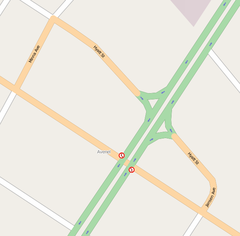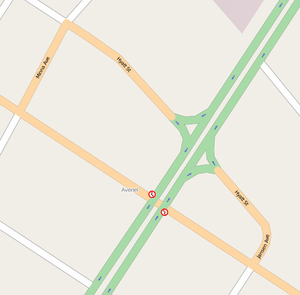Ko:Highway link

|
| 설명 |
| 도로를 연결하는 것을 나타내는 도로 태그 |
| 그룹 |
| 태그 |
|
highway=* |
_link 태그들은 진입로나 램프 등 연결 도로와 "독립"된 (물리적으로 분리된) 평면 교차로의 좌우 회전 차선에 사용합니다. '_link 태그는 신호 교차로에서 물리적으로 분리된 좌우 회전 차로나 주요 (가운데에 있는) 회전 교차로에서 물리적으로 독립된 차로인 경우에만 사용하여야 합니다.
일반적으로 사용되는 도로의 종류는 아래와 같습니다.
- highway=motorway_link
- highway=trunk_link
- highway=primary_link
- highway=secondary_link
- highway=tertiary_link
태그
Try not to split up the link into one part belonging to one road and one to the other with different classifications. This makes it more difficult to find out which roads a link is supposed to connect.
Link roads normally do not have names. Please use the destination=* and its extensions tag to give the cross-street's ref=* and signed destinations such as a city or the name of the destination street, so that routing engines can correctly announce the exit to the "name or ref of the destination street" as you enter the _link. Slip roads/ramps in the UK and USA do not have names, and very few of them have route refs. (If they have refs it is usually where an overlap begins or ends, such as US 30 jumping onto I-80 for a double-banded section[1].)
Grade-separated interchanges

At a grade-separated interchange, some major traffic movements pass above or below the others. This usually eliminates cross traffic from one of the intersecting highways (typically the motorway). At motorway to motorway interchanges, all at-grade cross-traffic conflicts are usually eliminated (though in the UK, a roundabout may sometimes connect two motorways). There are a very few grade separated interchanges in which both highways have at-grade turning traffic.[2]
The slip roads/ramps are usually considered to "belong" to the through highway they exit and enter. This is usually the higher classification of the intersecting highways because on and off ramps almost always have the same kind of restrictions as the main road [1], but in some cases this may be reversed.[3]
At-grade intersections
The most common type of _link cuts the corner at an intersection, leaving a small triangular "island" between it and the through carriageways/through lanes.
Sometimes, more complicated arrangements of links connect highways to each other, much like an interchange without bridges. Usually these eliminate direct left turns (see jughandle). Standard at-grade junctions in Spain require vehicles to exit right before making a left turn. Here too it probably makes more sense to consider the links as "belonging" to the more major highway.
Note that a regular surface road may be used for the same purpose. A preexisting street used to connect two major highways is not a link. Instead it should be tagged as the normal highway it previously was, probably equivalent to the lower classification of the ones it connects. This also applies where otherwise minor streets connect highways at an interchange.[4]
Roundabouts
Links are also used in roundabout designs that physically separate a specific turn from the main roundabout.
Turning lanes
There are also physically channelized turning lanes in the central reservation/median of dual carriageways/divided highways.[5] They should be tagged with the _link classification of the road whose median they occupy.
Special considerations for motorways
In some countries (such as the United Kingdom, but not always in the United States), motorway has a legal implication: certain classes of vehicles (such as bicycles) and drivers (such as learners) cannot use motorways. The same restrictions apply to their motorway_links. So only the motorway_link tag should be used on connecting roads that have these restrictions.
Elsewhere, ramps that can only be accessed by using a part of the motorway should be motorway_links. Also, collector/distributor roads are motorway_links when they collect and distribute motorway traffic.[6]
A motorway may have a short ramp of the turning lane type normally seen at a surface intersection, either because the motorway has a right-in/right-out junction, or because it ends just beyond at the road these ramps connect. Either way, these should be motorway_links, wherever they provide motorway access or egress.
Also note that - unlike highway=motorway - highway=motorway_link does not imply oneway=yes, and so oneway=* should always be used for clarity. A two-way motorway_link should be tagged oneway=no.
Check this table to understand how you can connect different highway category.
Parallel carriageways
Notes
- ↑ An off-ramp from I-80 where US 30 leaves the shared section, near Granger, WY. The double-banded section arrives from the east, US 30 continues NW, I-80 continues SW.
- ↑ US 35 and SR 32 near Jackson, Ohio
- ↑ US 301 and SR 20 in Hawthorne, Florida: although US 301 has the higher classification, it has traffic signals, while SR 20 passes overhead.
- ↑ I-4 and Kaley Avenue in Orlando, Florida: the portions of Avondale and Tallokas Avenues that connect the I-4 ramps to Kaley Avenue are secondary to match Kaley
- ↑ US 13/US 40 and Route 273 near New Castle, Delaware includes examples of both
- ↑ I-295 and Rancocas Mount Holly Road in New Jersey: traffic eastbound on Rancocas Mount Holly Road can take the ramp to I-295 north, and then take exit 45B from the C/D road back onto westbound Rancocas Mount Holly Road, without using I-295, but these two loop ramps and the C/D _link between them should be motorway_links, not primary_links
| ||||||||||||||||||||||||||||||
